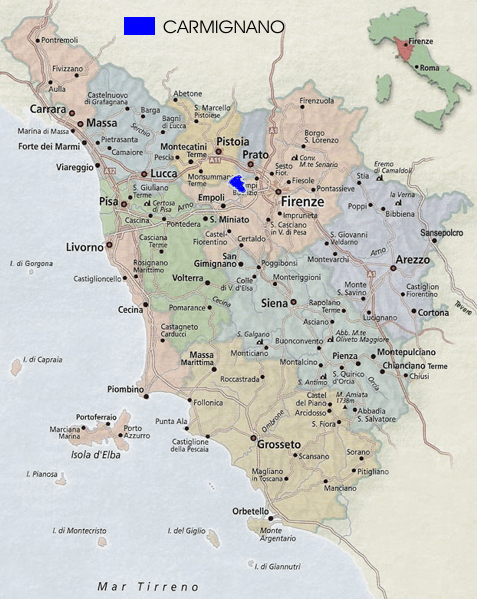our
territory
Carmignano is one of the oldest wines in Italy.
In Carmignano wine was produced since Etruscan times, as evidenced by the discovery of wine vessels in some Etruscan tombs on Monte Albano.
The first written documentation in which the name of a Carmignano wine appears dates back to 1396; it is a document in which a notary of Carmignano, Ser Lapo Mazzei, communicates to a merchant of Prato, Marco Datini, that he has ordered for his wine cellar fifteen some of wine Charmignano paying it “16 lire la soma “, a price four times higher than that of the wines of the area (which demonstrated its superior qualities).
In the seventeenth century the Carmignano wine is also mentioned by the poet Francesco Redi, who in the work “Bacco in Tuscany” enhances its qualities:
Giara I take in hand / brilliant Carmignano, / so grateful in sen it rains, / ambrosia and nectar do not envy to Jupiter. / Or this, which oozed to the uve brune / of stalking Tuscan vineyards / drink, Arianna, and keeps distant from him / the chiomazzurre Naiadi importune / that saria / madness / and very bad sin / drink the Carmignan when it is watered down.


The Carmignano region was the first DOC in Tuscany to use the blend Cabernet Sauvignon and Sangiovese. Carmignano can be considered the progenitor of the so-called wines Super tuscan (great Tuscan wines obtained by adding to the Sangiovese international vines such as Cabernet-Sauvignon or Merlot); in fact, since the 1600s for its production it was used to add to the Sangioveto Cabernet, a vine imported from France by the Medici (and still today called in the Francesca grape area, ie coming from France).
The edict of 1716 by Cosimo III de ‘Medici, Grand Duke of Tuscany, gave legal recognition to the wine of Carmignano.
The production area of Carmignano has been defined since 1716; in fact, on September 24 of that year in Florence the Grand Duke Cosimo III de ‘Medici issued the Notice on the Declaration of the Borders of the four Regions of Chianti,Pomino,Carmignano, and Val d’Arno di Sopra, in which the boundaries of the zones were specified within which the mentioned wines could be produced (in practice a real anticipation of the concept of Controlled Denomination of Origin).
Two months earlier, on July 18, 1716, a call was issued that established a Congregation that would have to control the wines “that are committed to navigate” that is suitable for traveling by sea (Carmignano, Pomino, Chianti and Valdarno).
The Congregation had to make sure that they were not tampered with and adulterated during the journey. Those wines were in fact considered important for the “decorum of the Nation”.
Sulla capacità del Carmignano a viaggiare troviamo altre informazioni: Lorenzo Biancardi di Livorno spedisce in data 31 marzo 1714, a mezzo nave olandese, diversi barili di vino Carmignano in Inghilterra e a Malta. Targioni Tozzetti, nel 1774, parla per la zona di Carmignano di “vini e olii ottimi, annoverati tra i migliori della Toscana“. Nel 1843 Emanuele Repetti scrive che nel territorio di Carmignano prosperano “quelle viti che forniscono il brillante Carmignano, uno dei migliori e più ricercati vini della Toscana”.
On the ability of Carmignano to travel we find other information: Lorenzo Biancardi of Livorno sends March 31st 1714, by Dutch ship, several barrels of Carmignano wine in England and Malta. Targioni Tozzetti, in 1774, speaks for the Carmignano area of ”excellent wines and oils, counted among the best in Tuscany“.
In 1843 Emanuele Repetti writes that in the territory of Carmignano “those vines that provide the brilliant Carmignano, one of the best and most sought-after wines of Tuscany”
Moreover, “the area is also favorable to the olive tree and to many other delicate fruits.” In fact the second resource of the owners of this soil consists of the oil, whose plants are covered in the hills and the humblest slopes of the mountain..“
L’Amati, in his “Geographical Dictionary of Italy” (1870) recommends, among other wines, Carmignano “exquisite“. Il Cusmano (1889) in the “Methodical-Alphabetical Dictionary of Viticulture and Oenology” mentions Carmignano among the best wines produced in Tuscany. Il Palgiani (1891) in the “Supplement to the sixth edition of the” Italian Encyclopedia “states, under the heading” Carmignano”


